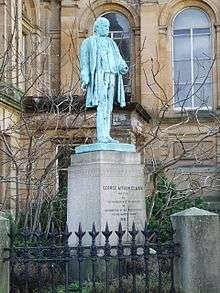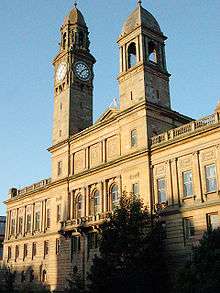George Aitken Clark
George Aitken Clark (1823–1873) was a Scottish manufacturer and benefactor.

Life
He was the son of John Clark, a thread manufacturer in Paisley, where he was born on 9 August 1823. He was educated at Paisley grammar school, and in 1840 was sent the firm of Kerr & Co. of Hamilton, Ontario. On reaching manhood he returned to Paisley, and entered into partnership with Messrs. Robert and John Ronald, shawlmakers, under the name of "Ronald & Clark".[2]
In 1851 Clark gave up his partnership to go into with his brother-in-law, Robert Kerr, as a thread manufacturer. To extend the business he went in 1856 to the United States, and to avoid the tariffs the firm in 1864 established a factory at Newark, New Jersey. It was a success, and Clark's O.N.T. spool cotton soon became a recognised American brand. In 1866 the firm amalgamated with the original firm of Clark under the name of Clark & Co.,with an anchor as their trade-mark. Clark died at Newark on 13 February 1873.[2]
Legacy

By his will Clark left £20,000 for scholarships at Glasgow University, and £20,000 to build a town hall in Paisley. The firm of Clark & Co. subscribed a further £40,000, and the building then styled the George A. Clark Town Hall was opened in 1882.[2] The architect was William Henry Lynn.[3]
Notes
- Paisley's Public Sculptures (PDF) Archived 4 January 2014 at the Wayback Machine at p. 5.
- Stephen, Leslie, ed. (1887). . Dictionary of National Biography. 10. London: Smith, Elder & Co.
- Larmour, Paul. "Lynn, William Henry". Oxford Dictionary of National Biography (online ed.). Oxford University Press. doi:10.1093/ref:odnb/63609. (Subscription or UK public library membership required.)
- Attribution
![]()